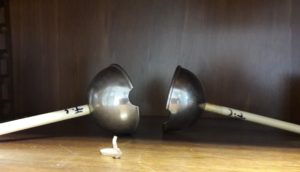
IT – Lo strumento, ideato dal fisico scozzese Henry Cavendish alla fine del 1700, mostra come le cariche poste su un corpo conduttore si distribuiscono sempre sulla superficie esterna. Esso è costituito da una sfera metallica, montata su un supporto verticale isolante, e due emisferi, di raggio appena superiore a quello della sfera, muniti ciascuno di un manico isolante, cosicché si possano chiudere a contatto con la sfera. Dopo aver caricato la sfera (se ne può verificare la carica avvicinandola ad un elettroscopio a foglie), si avvicinano i due emisferi “scarichi” in modo che vadano a “coprire” la sfera carica e subito dopo si riallontanano. Con l’aiuto di un elettroscopio si potrà osservare che i due emisferi sono adesso carichi mentre la sfera si è scaricata: questo mostra appunto che la carica si è spostata dalla sfera ai due emisferi, disponendosi sulla superficie esterna dell’unico conduttore formato dai tre in contatto.
GB – Cavendish hemispheres – The instrument, conceived by the Scottish physicist Henry Cavendish at the end of the 18th century, shows how the charges placed on a conducting body are always distributed on the external surface. It consists of a metal sphere, mounted on an insulating vertical support, and two hemispheres, of a radius just greater than that of the sphere, each equipped with an insulating handle, so that they can close in contact with the sphere. After having loaded the sphere (the charge can be verified by approaching it to a leaf electroscope), the two “discharged” hemispheres are approached so that they go to “cover” the charged sphere and immediately move away. With the help of an electroscope it will be possible to observe that the two hemispheres are now charged while the sphere has discharged: this shows precisely that the charge has moved from the sphere to the two hemispheres, placing itself on the external surface of the only conductor formed by the three in contact.